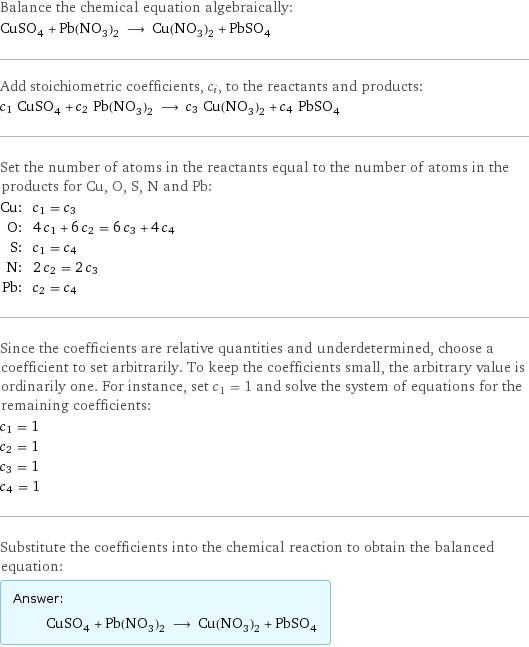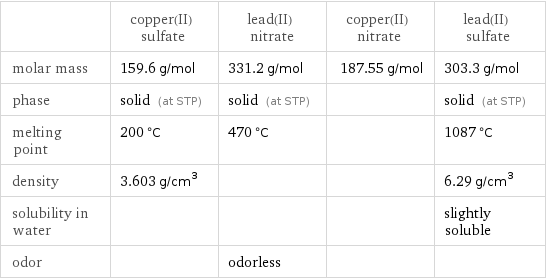Input interpretation

CuSO_4 copper(II) sulfate + Pb(NO_3)_2 lead(II) nitrate ⟶ Cu(NO_3)_2 copper(II) nitrate + PbSO_4 lead(II) sulfate
Balanced equation

Balance the chemical equation algebraically: CuSO_4 + Pb(NO_3)_2 ⟶ Cu(NO_3)_2 + PbSO_4 Add stoichiometric coefficients, c_i, to the reactants and products: c_1 CuSO_4 + c_2 Pb(NO_3)_2 ⟶ c_3 Cu(NO_3)_2 + c_4 PbSO_4 Set the number of atoms in the reactants equal to the number of atoms in the products for Cu, O, S, N and Pb: Cu: | c_1 = c_3 O: | 4 c_1 + 6 c_2 = 6 c_3 + 4 c_4 S: | c_1 = c_4 N: | 2 c_2 = 2 c_3 Pb: | c_2 = c_4 Since the coefficients are relative quantities and underdetermined, choose a coefficient to set arbitrarily. To keep the coefficients small, the arbitrary value is ordinarily one. For instance, set c_1 = 1 and solve the system of equations for the remaining coefficients: c_1 = 1 c_2 = 1 c_3 = 1 c_4 = 1 Substitute the coefficients into the chemical reaction to obtain the balanced equation: Answer: | | CuSO_4 + Pb(NO_3)_2 ⟶ Cu(NO_3)_2 + PbSO_4
Structures

+ ⟶ +
Names

copper(II) sulfate + lead(II) nitrate ⟶ copper(II) nitrate + lead(II) sulfate
Equilibrium constant
![Construct the equilibrium constant, K, expression for: CuSO_4 + Pb(NO_3)_2 ⟶ Cu(NO_3)_2 + PbSO_4 Plan: • Balance the chemical equation. • Determine the stoichiometric numbers. • Assemble the activity expression for each chemical species. • Use the activity expressions to build the equilibrium constant expression. Write the balanced chemical equation: CuSO_4 + Pb(NO_3)_2 ⟶ Cu(NO_3)_2 + PbSO_4 Assign stoichiometric numbers, ν_i, using the stoichiometric coefficients, c_i, from the balanced chemical equation in the following manner: ν_i = -c_i for reactants and ν_i = c_i for products: chemical species | c_i | ν_i CuSO_4 | 1 | -1 Pb(NO_3)_2 | 1 | -1 Cu(NO_3)_2 | 1 | 1 PbSO_4 | 1 | 1 Assemble the activity expressions accounting for the state of matter and ν_i: chemical species | c_i | ν_i | activity expression CuSO_4 | 1 | -1 | ([CuSO4])^(-1) Pb(NO_3)_2 | 1 | -1 | ([Pb(NO3)2])^(-1) Cu(NO_3)_2 | 1 | 1 | [Cu(NO3)2] PbSO_4 | 1 | 1 | [PbSO4] The equilibrium constant symbol in the concentration basis is: K_c Mulitply the activity expressions to arrive at the K_c expression: Answer: | | K_c = ([CuSO4])^(-1) ([Pb(NO3)2])^(-1) [Cu(NO3)2] [PbSO4] = ([Cu(NO3)2] [PbSO4])/([CuSO4] [Pb(NO3)2])](../image_source/94a67e9cf0b0e6c32b96afb08ebe3dc0.png)
Construct the equilibrium constant, K, expression for: CuSO_4 + Pb(NO_3)_2 ⟶ Cu(NO_3)_2 + PbSO_4 Plan: • Balance the chemical equation. • Determine the stoichiometric numbers. • Assemble the activity expression for each chemical species. • Use the activity expressions to build the equilibrium constant expression. Write the balanced chemical equation: CuSO_4 + Pb(NO_3)_2 ⟶ Cu(NO_3)_2 + PbSO_4 Assign stoichiometric numbers, ν_i, using the stoichiometric coefficients, c_i, from the balanced chemical equation in the following manner: ν_i = -c_i for reactants and ν_i = c_i for products: chemical species | c_i | ν_i CuSO_4 | 1 | -1 Pb(NO_3)_2 | 1 | -1 Cu(NO_3)_2 | 1 | 1 PbSO_4 | 1 | 1 Assemble the activity expressions accounting for the state of matter and ν_i: chemical species | c_i | ν_i | activity expression CuSO_4 | 1 | -1 | ([CuSO4])^(-1) Pb(NO_3)_2 | 1 | -1 | ([Pb(NO3)2])^(-1) Cu(NO_3)_2 | 1 | 1 | [Cu(NO3)2] PbSO_4 | 1 | 1 | [PbSO4] The equilibrium constant symbol in the concentration basis is: K_c Mulitply the activity expressions to arrive at the K_c expression: Answer: | | K_c = ([CuSO4])^(-1) ([Pb(NO3)2])^(-1) [Cu(NO3)2] [PbSO4] = ([Cu(NO3)2] [PbSO4])/([CuSO4] [Pb(NO3)2])
Rate of reaction
![Construct the rate of reaction expression for: CuSO_4 + Pb(NO_3)_2 ⟶ Cu(NO_3)_2 + PbSO_4 Plan: • Balance the chemical equation. • Determine the stoichiometric numbers. • Assemble the rate term for each chemical species. • Write the rate of reaction expression. Write the balanced chemical equation: CuSO_4 + Pb(NO_3)_2 ⟶ Cu(NO_3)_2 + PbSO_4 Assign stoichiometric numbers, ν_i, using the stoichiometric coefficients, c_i, from the balanced chemical equation in the following manner: ν_i = -c_i for reactants and ν_i = c_i for products: chemical species | c_i | ν_i CuSO_4 | 1 | -1 Pb(NO_3)_2 | 1 | -1 Cu(NO_3)_2 | 1 | 1 PbSO_4 | 1 | 1 The rate term for each chemical species, B_i, is 1/ν_i(Δ[B_i])/(Δt) where [B_i] is the amount concentration and t is time: chemical species | c_i | ν_i | rate term CuSO_4 | 1 | -1 | -(Δ[CuSO4])/(Δt) Pb(NO_3)_2 | 1 | -1 | -(Δ[Pb(NO3)2])/(Δt) Cu(NO_3)_2 | 1 | 1 | (Δ[Cu(NO3)2])/(Δt) PbSO_4 | 1 | 1 | (Δ[PbSO4])/(Δt) (for infinitesimal rate of change, replace Δ with d) Set the rate terms equal to each other to arrive at the rate expression: Answer: | | rate = -(Δ[CuSO4])/(Δt) = -(Δ[Pb(NO3)2])/(Δt) = (Δ[Cu(NO3)2])/(Δt) = (Δ[PbSO4])/(Δt) (assuming constant volume and no accumulation of intermediates or side products)](../image_source/89132f784d630f949183cf813bf3e2fa.png)
Construct the rate of reaction expression for: CuSO_4 + Pb(NO_3)_2 ⟶ Cu(NO_3)_2 + PbSO_4 Plan: • Balance the chemical equation. • Determine the stoichiometric numbers. • Assemble the rate term for each chemical species. • Write the rate of reaction expression. Write the balanced chemical equation: CuSO_4 + Pb(NO_3)_2 ⟶ Cu(NO_3)_2 + PbSO_4 Assign stoichiometric numbers, ν_i, using the stoichiometric coefficients, c_i, from the balanced chemical equation in the following manner: ν_i = -c_i for reactants and ν_i = c_i for products: chemical species | c_i | ν_i CuSO_4 | 1 | -1 Pb(NO_3)_2 | 1 | -1 Cu(NO_3)_2 | 1 | 1 PbSO_4 | 1 | 1 The rate term for each chemical species, B_i, is 1/ν_i(Δ[B_i])/(Δt) where [B_i] is the amount concentration and t is time: chemical species | c_i | ν_i | rate term CuSO_4 | 1 | -1 | -(Δ[CuSO4])/(Δt) Pb(NO_3)_2 | 1 | -1 | -(Δ[Pb(NO3)2])/(Δt) Cu(NO_3)_2 | 1 | 1 | (Δ[Cu(NO3)2])/(Δt) PbSO_4 | 1 | 1 | (Δ[PbSO4])/(Δt) (for infinitesimal rate of change, replace Δ with d) Set the rate terms equal to each other to arrive at the rate expression: Answer: | | rate = -(Δ[CuSO4])/(Δt) = -(Δ[Pb(NO3)2])/(Δt) = (Δ[Cu(NO3)2])/(Δt) = (Δ[PbSO4])/(Δt) (assuming constant volume and no accumulation of intermediates or side products)
Chemical names and formulas

| copper(II) sulfate | lead(II) nitrate | copper(II) nitrate | lead(II) sulfate formula | CuSO_4 | Pb(NO_3)_2 | Cu(NO_3)_2 | PbSO_4 Hill formula | CuO_4S | N_2O_6Pb | CuN_2O_6 | O_4PbS name | copper(II) sulfate | lead(II) nitrate | copper(II) nitrate | lead(II) sulfate IUPAC name | copper sulfate | plumbous dinitrate | copper(II) nitrate |
Substance properties

| copper(II) sulfate | lead(II) nitrate | copper(II) nitrate | lead(II) sulfate molar mass | 159.6 g/mol | 331.2 g/mol | 187.55 g/mol | 303.3 g/mol phase | solid (at STP) | solid (at STP) | | solid (at STP) melting point | 200 °C | 470 °C | | 1087 °C density | 3.603 g/cm^3 | | | 6.29 g/cm^3 solubility in water | | | | slightly soluble odor | | odorless | |
Units
